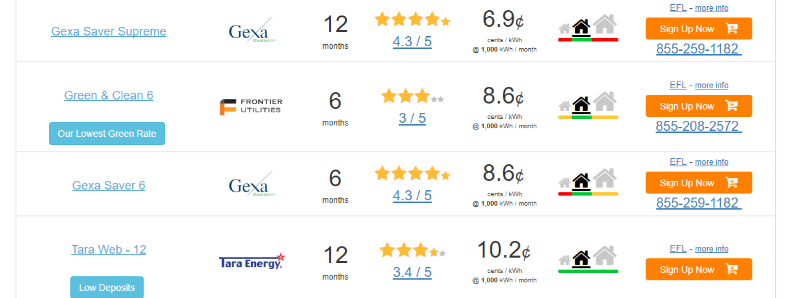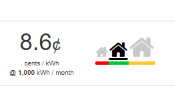The Texas electricity market has been de-regulated since 2002, and Texas Electricity Ratings has been helping customers find the right electricity plans to meet their needs since 2008. While it’s hard to believe we’ve been doing this for 10 years, what sadly isn’t difficult to believe is that the Texas Electricity Market is still confusing, complex, and customers struggle to understand exactly what they might be getting with the plans they’re ordering online. And chances are that this lack of understanding of the marketplace is a battle that we’ll be fighting here at Texas Electricity Ratings until the end of time.
While shopping for electricity should be as simple as looking at the price advertised next to a plan’s name, unfortunately, that isn’t always the case. For starters, no matter what price is listed, customers don’t always understand that the rate their paying with a single electricity plan will, more times than not, vary depending on a customers usage. Here’s a snippet from the Electricity Facts Label (EFL) from a plan offered by an electricity company in Texas:

As you can see, there are 3 different rates listed for 3 different sets of usage. We have an entire resources page for explaining EFLs to customers, but the important thing to understand for this article as that the same plan can charge you 3 different rates depending on how much electricity you can use each month. This is pretty standard in the state of Texas. In fact it’s more uncommon to see flat rates across the 3 different usage categories than it is to see big variations like the one in the EFL above us. So if a customer using the plan above say, lives in an apartment and doesn’t use much electricity, they’re actually paying a per kWh rate more than DOUBLE what someone in a small house who uses between 1,000 and 2,000 kWh per month. Most people don’t understand this because the rates only need to be advertised by 1 of the 3 rates listed above. If you use more than 2,000 kWh, you end up paying a reasonable rate of 10.4 kWh. Make sense?
That beings me to the whole point of this article, which is to talk about Texas Electricity Ratings new shopping tool and the most recent steps we’re taking to help customers understand how to shop for electricity and to make sure they end up in the best plan possible for their home energy usage. Recently, we redesigned our website and created functionality to hopefully allow our customers a chance to understand the different changes a single plan can have depending on usage. In essence, we tried to create an illustration of the different levels of usage listed in the EFL above. Here’s how a plan on our site looks now:

I’d like to bring your attention to the images of the houses and the color lines beneath them, one for each individual plan that is listed. Those houses represent the usage levels listed on an EFL, the small house being 500, the medium house being 1,000 to 2,000 kWh, and the large house being more than 2,000 kWh of usage in a month. Since the prices can vary so much depending on usage, we made the houses clickable. So when a customer in an apartment clicks on the small house, then all the prices on the website switch to that level of usage. This is to make it much easier for shoppers to see what the actual rate they’ll be paying, depending on their estimated monthly usage. This should make understanding what a customer can expect on their bill much much clearer than how electricity is sold currently on most websites, including the state sponsored Power To Choose.
However, the thing we’re really proud of here at Texas Electricity Ratings is the colored bar below the houses. With the clickable houses, customers can quickly cycle through the different rates based on their usage. But without even doing any of that, the colored bars can tell a customer plenty of insightful information.



The colors work to indicate the difference in rate change across the usage categories. So basically, it indicates that there is either large, medium, or small change in the rates from usage level to usage level. A plan that only changed 15% between 500, 1000, and 2000 kWh of usage would be completely green, or what we call “flat.” In other words the rate doesn’t change much regardless of usage. In the illustration above, we see a plan with 3 different colors listed, and when you look at the prices for each usage category, it becomes clear. The red bar measures the difference between the 14.1 cent rage and the 8.6 rate, which is very substantial. The 8.6 rate and the 10.8 cent rate at 2000 usage gets a yellow bar. The lowest usage category of the 3 always gets a green bar. The purpose here is NOT for Texas Electricity Ratings to tell you if a different plan is a “good rate” or a “bad rate,” it is designed to tell you if there’s a large variance in the rate a customer is paying in different usage categories. Plenty of plans might actually still be good rates, but have a green and a red the 1,000 and 2,000 usage categories, it could just mean one rate is REALLY good and the other rate is just good. That’s something that customers will hopefully learn for themselves while shopping on our website. But in this day and age of ballooning Minimum Usage Charges, or Bill Credits based on certain usage numbers, there are many different methods electricity providers can use to make certain plans look attractive to the customer when in fact there could be some hidden pitfalls that could create some much higher than expected bills.
And that is what this new redesign and functionality is targeting to help customers in their shopping process. Just like everyone understands the basic concept of red, yellow, and green lights when they’re behind the wheel of a car, here at Texas Electricity Ratings we’re hoping to harness a similar method to guide customers and get there attention. If you see green bars on a plan, what you see is what you get. If you see a green and yellow, you probably need to slow down and exercise some caution. And if you see reds on a bar, you probably need to stop your shop and really analyze the plan you’re considering ordering. Because it might still be a great plan to fit your lifestyle and needs, but it’s best to pause and make sure the rates at different usage levels make sense to you and your budget.
